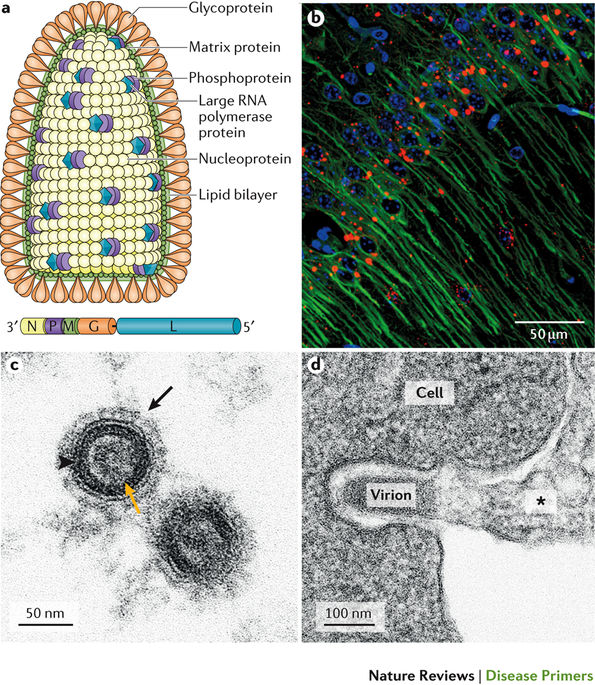狂犬病
Rabies
2017年11月30日 Nature Reviews Disease Primers 3 : 17091 doi: 10.1038/nrdp.2017.91

狂犬病は致死性の熱帯病で、アフリカやアジアを中心とする流行国では年間数万例が報告されているが、実際の症例数はおそらくこれを上回るとみられる。狂犬病は、感染動物の唾液を介して伝播されるリッサウイルス属ウイルスの感染による人獣共通感染症である。犬は狂犬病ウイルスの最も主たる感染源であり、ヒトの症例の99%以上が犬の咬傷によるものである。このウイルスは、先ず末梢運動ニューロンに感染した後、中枢神経系に達して症状を発現させる。ひとたび臨床症状が現れると、ほぼ確実に死に至る。狂犬病の一次予防では、ウイルス保有動物を減らすために犬の予防接種キャンペーンが行われる。曝露後でも、適切な創傷ケア、抗狂犬病免疫グロブリン投与、予防接種などの曝露後予防を適時に行えば、臨床症状の発現を抑えることができる。WHOでは、2030年までにイヌ媒介性ヒト狂犬病による死亡者をゼロにすることを目標に掲げている。これを達成するためには、政府の支援に加えて、狂犬病の啓発や感染疑い例へのワクチンの接種など、ヒト狂犬病撲滅に向けた多面的な取組みが必要であり、とりわけ、狂犬病の発生拡大を防止することが最も重要である。
PrimeView
狂犬病の死亡率はほぼ100%であるため、予防は必要不可欠である。このPrimeViewでは、犬の予防接種キャンペーンを通して犬からヒトへの狂犬病ウイルスの感染を阻止し、曝露後予防による症状の発現抑制を重要視した有用なアプローチについて取りまとめる。
本Primerの図解サマリー
Rabies is a life-threatening neglected tropical disease: tens of thousands of cases are reported annually in endemic countries (mainly in Africa and Asia), although the actual numbers are most likely underestimated. Rabies is a zoonotic disease that is caused by infection with viruses of the Lyssavirus genus, which are transmitted via the saliva of an infected animal. Dogs are the most important reservoir for rabies viruses, and dog bites account for >99% of human cases. The virus first infects peripheral motor neurons, and symptoms occur after the virus reaches the central nervous system. Once clinical disease develops, it is almost certainly fatal. Primary prevention involves dog vaccination campaigns to reduce the virus reservoir. If exposure occurs, timely post-exposure prophylaxis can prevent the progression to clinical disease and involves appropriate wound care, the administration of rabies immunoglobulin and vaccination. A multifaceted approach for human rabies eradication that involves government support, disease awareness, vaccination of at-risk human populations and, most importantly, dog rabies control is necessary to achieve the WHO goal of reducing the number of cases of dog-mediated human rabies to zero by 2030.

